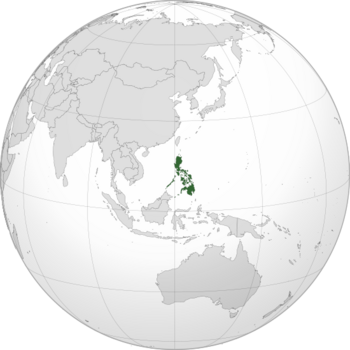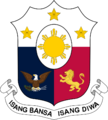History of the Philippines (1965–1986) facts for kids
Quick facts for kids
Republic of the Philippines
Republika ng Pilipinas (Filipino)
|
|||||||||
|---|---|---|---|---|---|---|---|---|---|
| 1965–1986 | |||||||||
|
|
|||||||||
|
Motto: "Isang Bansa, Isang Diwa"
"One Nation, One Spirit" |
|||||||||
|
March: Bagong Pagsilang
(English: "New Birth") |
|||||||||

Location of the Philippines in Southeast Asia.
|
|||||||||
| Capital | 1965–1976: Quezon City (official) Manila (legislative capital until 1972) 1976–1986: Manila (de jure) Metro Manila (de facto) |
||||||||
| Largest city | Quezon City (city proper) Metro Manila (metropolitan) |
||||||||
| Official languages | Filipino Spanish English |
||||||||
| Spoken languages | See Languages of the Philippines | ||||||||
| Government | Unitary presidential constitutional republic (1965–1972)
Unitary presidential constitutional republic under an authoritarian conjugal military dictatorship (1972–1973) Unitary parliamentary republic with an executive presidency (1973–1978) Unitary dominant-party parliamentary constitutional republic under an authoritarian conjugal military dictatorship (1978–1981) Unitary dominant-party semi-presidential constitutional republic under a conjugal dictatorship (1981–1986) Revolutionary government (1986) |
||||||||
| President | |||||||||
|
• 1965–1986
|
Ferdinand Marcos | ||||||||
|
• 1986
|
Corazon Aquino | ||||||||
| Vice President | |||||||||
|
• 1965–1972
|
Fernando Lopez | ||||||||
|
• 1972–1986
|
abolished by the 1973 Constitution | ||||||||
|
• 1986
|
Salvador Laurel | ||||||||
| Prime Minister | |||||||||
|
• 1978–1981
|
Ferdinand Marcos | ||||||||
|
• 1981–1986
|
Cesar Virata | ||||||||
|
• 1986
|
Salvador Laurel | ||||||||
| Legislature | Congress (1965–1972) None (Congress dissolved) (1972–1976) Batasang Bayan (1976–1978) Interim Batasang Pambansa (1978–1984) Regular Batasang Pambansa (1984–1986) |
||||||||
| Senate (1965–1972) |
|||||||||
| House of Representatives (1965–1972) |
|||||||||
| Historical era | Cold War | ||||||||
|
• Inauguration of Ferdinand Marcos
|
December 30, 1965 | ||||||||
|
• First Quarter Storm
|
January 26 – March 17, 1970 | ||||||||
|
• Plaza Miranda bombing
|
August 21, 1971 | ||||||||
|
• Proclamation 1081
|
September 23, 1972 | ||||||||
|
• 1973 Constitution
|
January 17, 1973 | ||||||||
|
• Assassination of Ninoy Aquino
|
August 21, 1983 | ||||||||
|
• 1986 snap election
|
February 7, 1986 | ||||||||
| February 22–25, 1986 | |||||||||
| February 25, 1986 1986 | |||||||||
| Currency | Philippine peso (₱) | ||||||||
| Time zone | UTC+08:00 (PST) | ||||||||
| Date format |
|
||||||||
| Driving side | right | ||||||||
| ISO 3166 code | PH | ||||||||
|
|||||||||
| Today part of | Philippines | ||||||||
This article tells the story of the history of the Philippines from 1965 to 1986. This period was when Ferdinand Marcos was president. It includes the last years of the Third Philippine Republic (1965–1972), the time when the Philippines was under martial law (1972–1981), and most of the Fourth Philippine Republic (1981–1986). By the end of Marcos's rule, the country faced many problems, including a huge debt, widespread poverty, and many people without enough work.
Contents
The Marcos Years: 1965–1972
First Term as President

In 1965, Ferdinand Marcos won the presidential election. He became the 10th president of the Philippines. During his first term, the country saw more factories and new roads being built. Important projects included the North Luzon Expressway and the Maharlika Highway.
In 1968, Senator Benigno Aquino Jr. warned that Marcos was making the military too strong. He worried that Marcos was preparing to take full control of the government.
During the Vietnam War, Marcos did not want to send soldiers to Vietnam. However, the U.S. President Lyndon Johnson strongly pushed him to help. So, in 1966, Marcos sent a group of Filipino non-combatants (people who help but don't fight) to Vietnam. This group was called the Philippine Civic Action Group (PHILCAG). Many Filipinos did not support the war, so Marcos ordered the PHILCAG to leave Vietnam in November 1969.
Second Term and Growing Problems
In 1969, Marcos ran for president again. He won by a large number of votes against 11 other candidates. This was his last term allowed by the 1935 constitution.
However, Marcos spent a lot of money during his 1969 election campaign. This caused big economic problems for the country. The government had to ask the International Monetary Fund (IMF) for help. New rules were put in place, like focusing more on exports. The value of the Philippine Peso dropped a lot, which led to high prices for goods and services. This made many people unhappy and caused social unrest.

In February 1971, student activists took over the Diliman campus of the University of the Philippines. They called it a "free commune." Protests during the First Quarter Storm in 1970 led to clashes with the police.
During these protests, some student activists joined the Communist Party. They protested in front of Congress, throwing things at Ferdinand and Imelda Marcos. At the presidential palace, activists broke through the gate and threw rocks and firebombs. Protesters also damaged the U.S. embassy. These protests involved tens of thousands of people. At least two activists died, and many were hurt.
There were also rumors that some groups were planning to overthrow the government. Some reports suggested that retired military officers were planning to remove President Marcos.
Plaza Miranda Bombing
On August 21, 1971, the Liberal Party held a big meeting at Plaza Miranda in Manila. They were announcing their candidates for the upcoming elections. During the event, two grenades were thrown onto the stage. Almost everyone there was injured.
After the bombing, Marcos said that communist groups were behind the attack. He then stopped the "writ of habeas corpus." This allowed him to arrest people without needing to bring them to court quickly. He arrested many people he thought were involved, including some of his political rivals.
Alleged Ambush of Juan Ponce Enrile
On September 22, 1972, Defense Minister Juan Ponce Enrile was reportedly ambushed on his way home. This event, along with the Plaza Miranda bombing and other incidents, was used by Marcos to justify a major change in the country.
Martial Law: 1972–1981
On September 21, 1972, President Marcos declared martial law across the Philippines. He said he did this because of the Plaza Miranda bombing, the alleged ambush of Enrile, and general unrest.
Under martial law, Marcos took almost complete control. He stopped freedom of the press and other basic rights. He closed down Congress and controlled news organizations. He also ordered the arrest of many opposition leaders and activists. These included his strongest critics, Senators Benigno Aquino Jr. and Jose W. Diokno. This turned the Philippines into a country where Marcos had almost total power.
At first, some people welcomed martial law because crime rates went down. However, as martial law continued for nine years, the military committed many abuses. Thousands of people were killed without trial, and tens of thousands were put in jail. Many Filipinos also disappeared.
Many people believed that Marcos declared martial law to stay in power longer. His term as president was about to end, and the constitution did not allow him to run again. This suspicion grew stronger when opposition leaders and critics were immediately arrested. Travel, communication, and freedom of speech were also restricted.
In December 1980, President Marcos announced that he would lift martial law by the end of January 1981. He said he wanted to return to a more normal government.
Martial law was officially lifted in January 1981. However, Marcos still held a lot of power. He kept many of the laws and decrees he made during martial law. This allowed him to continue jailing political opponents.
Economy During Martial Law
The Philippine economy grew a lot during the early years of martial law. From 1972 to 1980, the country's total economic output (GDP) quadrupled. This meant an average growth of 6% each year. The economy grew even during times of high oil prices in 1973 and 1979.
However, the government started borrowing a lot of money from other countries in the early 1980s. The country's total foreign debt grew from $2.3 billion in 1970 to $26.2 billion in 1985. Critics said that Marcos and his friends were misusing public money. This led to a huge debt problem for the country.
The value of the Philippine Peso also dropped significantly. The economy slowed down, and more people became unemployed, especially towards the end of Marcos's rule. This was made worse by a global economic slowdown and high oil prices. Economists noted that the number of people living in poverty increased greatly during Marcos's time in office. For example, on Negros Island, many children were severely malnourished.
Filipinos Moving Abroad
From 1965, when Marcos was elected, until 1986, when his rule ended, about 300,000 Filipinos moved to the United States.
Parliamentary Elections During Martial Law
The first elections since 1969 were held on April 7, 1978, for a new national assembly called the Batasang Pambansa. Senator Aquino, who was still in jail, ran as the leader of his party, the Lakas ng Bayan. However, his party did not win any seats. The night before the elections, supporters of the LABAN party held a "noise barrage" in Manila, making noise all night to show their support.
The Fourth Republic: 1981–1986
The opposition groups decided not to participate in the June 16, 1981, presidential election. This meant Marcos easily won against his opponent, allowing him to have another six-year term.
In 1983, opposition leader Benigno "Ninoy" Aquino Jr. was killed at Manila International Airport. He was returning to the Philippines after living in the United States for a long time. This event made many people very angry with Marcos. It led to a series of protests and pressure from other countries, especially the United States.
These events led to a special presidential election on February 7, 1986. The opposition united behind Aquino's widow, Corazon Aquino, and Salvador Laurel. However, the election was full of reports of cheating and violence from both sides.
The official election group, the COMELEC, announced that Marcos had won. But many computer technicians working for COMELEC walked out, saying the results were being changed. Another group that watched the elections, the National Citizens' Movement for Free Elections, said that Corazon Aquino had actually won.
End of the Marcos Regime
Most people, both in the Philippines and around the world, believed that the 1986 presidential election was unfair. International observers, including a U.S. group, said the official results were wrong. Corazon Aquino refused to accept the results. On February 16, 1986, she held a large rally in Manila, calling for people to protest and boycott businesses connected to Marcos. About two million people attended this rally.
After the election, Defense Minister Juan Ponce Enrile and a group of military officers planned to overthrow Marcos. However, Marcos found out about the plan and ordered their arrest.
Enrile and his allies, including Lt. Gen Fidel Ramos, barricaded themselves in two military camps in Quezon City. They were surrounded by Marcos's forces. A small group of Aquino supporters went to the main road, Epifanio de los Santos Avenue (EDSA), to support them. Ramos and Enrile also asked Cardinal Jaime Sin, a very important religious leader, for help. Cardinal Sin asked people in Manila to go to EDSA to support the military rebels.
This call led to the largely peaceful 1986 EDSA Revolution. Millions of Filipinos gathered on EDSA, forming a human shield around the military camps. This massive show of support prevented Marcos's forces from attacking. Marcos eventually went into exile in Hawaii. Corazon Aquino became the 11th president of the Philippines on February 25, 1986. Under Aquino, the Philippines adopted a new constitution, ending the Fourth Republic and starting the Fifth Philippine Republic.
Images for kids






